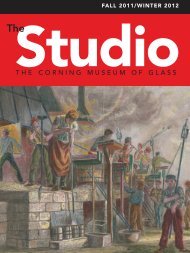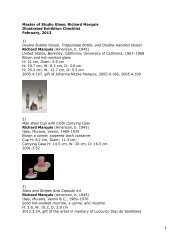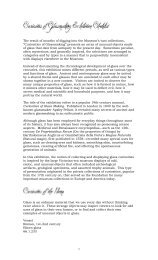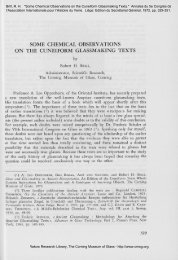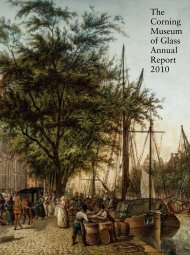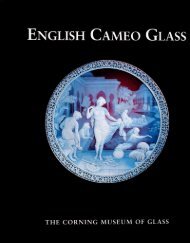Glass: A Pocket Dictionary Of Terms Commonly Used - Corning ...
Glass: A Pocket Dictionary Of Terms Commonly Used - Corning ...
Glass: A Pocket Dictionary Of Terms Commonly Used - Corning ...
You also want an ePaper? Increase the reach of your titles
YUMPU automatically turns print PDFs into web optimized ePapers that Google loves.
68<br />
Post: The glass used to attach a second pontil to glass<br />
that is about to be pulled into a cane.<br />
Post technique: instead of being applied to a vessel<br />
with a wad, the pontil is attached to a flat plate of glass<br />
called a “post,” which is then affixed to the base or footring<br />
of the vessel.<br />
Pot: A fire-clay container in which batch is fused and<br />
kept molten. The glassworker gathers glass directly<br />
from the pot.<br />
Potash: Potassium carbonate. it is an alternative to soda<br />
as a source of alkali in the manufacture of glass.<br />
Potash- or Potassium-lime glass: A form of glass containing<br />
three major compounds in varying proportions:<br />
silica (usually about 60–75 percent), potash (12–18 percent),<br />
and lime (5–12 percent). Forest glass is a common<br />
type of potassium-lime glass. Potash glass is slightly<br />
denser than soda-lime glass; it passes from the molten<br />
to the rigid state more quickly, and it is therefore more<br />
difficult to manipulate into elaborate forms. However,<br />
it is harder and more brilliant, and it lends itself to decorative<br />
techniques such as facet cutting and copperwheel<br />
engraving.<br />
Preserving jar: A jar for preserving food. The term refers<br />
to jars with a variety of methods for sealing the contents.<br />
John landis Mason perfected the first inexpensive method<br />
of sealing glass jars in 1858.<br />
Pressed glass: <strong>Glass</strong>ware formed by placing a blob<br />
of molten glass in a metal mold and pressing it with<br />
a metal plunger or “follower” to form the inside shape.<br />
The resultant piece, termed “mold-pressed,” has an<br />
interior form independent of the exterior, in contrast<br />
to mold-blown glass, whose interior corresponds to<br />
the outer form. The process of pressing glass was first



